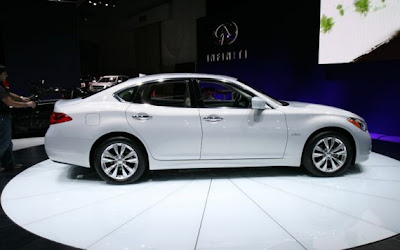Along with its V6-powered brother, the new 2011 Infiniti M37, Redesigned 2011 Infiniti M56, the midsize luxury sedan available with rear-wheel drive and four-wheel drive. As before, M is designed for those buyers who are looking for rewarding the commitment and drive their luxury cars, and Infiniti will not disappoint. Although M37 has all the power, you’ll probably never need that the 2011 Infiniti M56 is designed for those who want more.
INTERIOR
- Front 12V power outlet(s)
- Dual-zone fully-automatic climate control
- Diversity antenna
- Anti-theft protection
- Front and rear ashtray
- Audio system with AM/FM radio, CD player (reads MP3 format) ; includes RDS , satellite radio
- Cargo capacity: 14.9 cu. ft. all seats in place
- Cigar lighter in front seats
- Coming home device
- Compass
- Trip computer: includes average speed, average fuel economy, current fuel economy and range for remaining fuel
- Overhead consoles
- Cruise control
- Front cup holders
- Entertainment display screen located in front
- DVD/VCD
- Outside air temperature indicator
- Floor mats
- Intelligent driver front airbag, intelligent passenger front airbag with occupant sensors
- Heated ventilated and climate-controlled bucket driver seat with five 10-way power ; details: memorized height, power lumbar and memorized tilt, heated ventilated and climate-controlled bucket front passenger seat: with five 10-way power ; details: power height, power lumbar and power tilt
- Height adjustable front seat belts with pre-tensioners for driver and passenger
- Front seat center armrest
- Garage door opener
- Headlight control with dusk sensor
- Two active height-adjustable front head restraints, three height-adjustable rear seats head restraints
- Interior dimensions: 39.1 in. front headroom, 37.7 in. rear headroom, 54.3 in. front hip room, 53.5 in. rear hip room, 44.0 in. front leg room, 36.2 in. rear leg room, 58.4 in. front shoulder room, 56.7 in. rear shoulder room and 103.6 cu ft. interior volume
- Low tire pressure indicator
- Memorized adjustment: includes door mirror position and steering wheel position
- MP3 player
- Navigation system with 3D and voice
- RearView Monitor rear camera parking distance sensors
- Card key power locks , includes power windows and speed sensing
- Vehicle speed-proportional power steering
- Power windows, express driver and passenger
- Front and rear reading lights
- Rear seat belts for driver, rear seat belts for passenger, 3-point rear seat belts for center
- Rear seat center armrest with trunk access
- Rear seats:
- Auto-dimming rear view mirror
- Steering wheel-mounted audio controls
- Remote control trunk/hatch release
- Front and rear curtain airbag
- Seating: five passengers
- Leather upholstery
- Service interval indicator
- Front side airbag
- Intelligent Key smart card/smart key; includes central locking ; includes ignition starter and memory seat
- Ten Bose speakers
- Leather-trimmed, tilt/ telescoping steering wheel
- Tachometer
- Illuminated driver and passenger vanity mirror
- Ventilation system with micro filter and automatic recirculation
- Voice activating system for radio, phone and navigation system
- Body-color front and rear bumpers
- Driver and passenger power, heated ,body-color door mirrors, passenger power, heated ,body-color door mirrors
- Exterior dimensions: 194.7 in. overall length, 72.6 in. overall width, 59.6 in. overall height, 114.2 in. wheelbase, 62.0 in. front track, 61.6 in. rear track and 37.4 ft. curb-to-curb turning circle
- Electric foldable mirrors
- Front fog lights
- Bi-Xenon headlights with projector beam lenses
- Luxury trim: leather on shifter, wood/woodgrain on doors and wood/woodgrain on dashboard
- Pearl paint
- Rear window defroster
- Electric glass sunroof
- Weights: published curb weight (lbs): 4,224
- Intermittent windshield wipers
5.6-liter, 420-performance V8 2011 Infiniti M56 socks almost every competitor in its class. A decade ago, it was the substance M5 or AMG E-Class, and today it is still kick his feet were planted in the carpet. Yet not only has the 2011 Infiniti M56 engine M45 larger than its predecessor, but the sedan has all the gym too. Its curves, muscular styling hides a larger width and length, but also shorter height to enable more aggressive proportions. Interior dimensions changed little, which is fine, since M has been one of the more spacious cars in its class.
SAFETY
The number of comfort, safety, performance and entertainment features as standard and optional equipment lists to populate “War and Peace” look short. Not only that, new topics such as forest and Active Air Purifying System Trace Control was added, but before the function, such as better navigation. Perhaps best of all, many of these features live in the cottage, which is attractive and better place.
reference:autocarsnews.info,www.carseverything.com












































